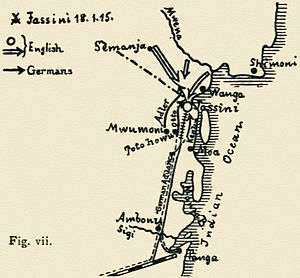Battle of Jassin
| Battle of Jassin | |||||||
|---|---|---|---|---|---|---|---|
| Part of the East African Campaign of World War I | |||||||
 | |||||||
| |||||||
| Belligerents | |||||||
|
| |||||||
| Commanders and leaders | |||||||
|
|
| ||||||
| Strength | |||||||
|
244 Europeans 1,350 Askaris 23 machine guns 4 field guns |
300 men in Jassin 800 in the relief force | ||||||
| Casualties and losses | |||||||
|
86 dead 200 wounded | |||||||
The Battle of Jassin (also known as the Battle of Yasin and the Battle of Jassini)[1] was a World War I battle that took place on 18– 19 January 1915 at Jassin on the German East African side of the border with British East Africa between a German Schutztruppe force and British and Indian troops. Jassin had been occupied by the British in order to secure the border between British East Africa and German territory, but was weakly defended by four companies of Indian troops—numbering a little over 300 men.
The German commander, Paul Emil von Lettow-Vorbeck, decided to attack Jassin in order to prevent further danger to Tanga, which lay more than 50 kilometres to the south and had previously been successfully defended against a British attack. Nine companies of Schutztruppe with European officers were gathered for the assault.
Immediately after the British force surrendered, British Captains Hanson and Turner were taken to see Lettow-Vorbeck. He congratulated them on their defence of the town before releasing them on the promise they would play no further part in the war.
Although the British force surrendered, Lettow-Vorbeck realised that the level of German losses of officers and ammunition meant that he could rarely afford confrontation on such a large scale and would need to make use of guerrilla warfare instead—he turned his attention away from seeking decisive battle against the British, concentrating instead on operations against the Uganda Railway.[2] The British response was to concentrate their forces to reduce their risks and make defence easier.
References
- ↑ Lettow-Vorbeck, Paul. My Reminisces of East Africa. London: Hurst and Blackett. p. 105.
- ↑ Paul von Lettow-Vorbeck, My Reminiscences of East Africa, 63-64.
Coordinates: 4°40′53″S 39°11′05″E / 4.6814°S 39.1847°E